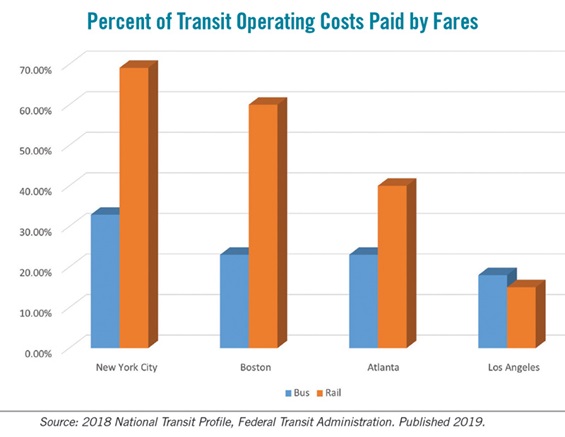Public Transit During COVID-19: Essential Service for Essential People

Safety on trains and buses will be a critical concern for cities in the foreseeable future.
The COVID-19 pandemic that gripped the U.S. earlier this year created a massive and immediate decline in all forms of travel as businesses shut down and governments issued stay-at-home orders. Transit ridership in many places dropped by 90% or more according to an April 2020 report from the Eno Transportation Foundation, “COVID’s Differing Impact on Transit Ridership.” Many commuters began working from home, unemployment grew, and both leisure and business travel almost ceased. Road traffic in the U.S. saw an unprecedented 40% reduction overall, according to an April report by the Federal Highway Administration.
While reduced travel means less greenhouse gases, a major environmental benefit, it also leads to lower revenues for transit agencies. Fares pay about 36% of transit system operating costs on average, according to a 2019 study by the Federal Transit Administration.
According to the American Public Transit Association (APTA), reduced revenues from depressed ridership, together with increased operating costs to protect workers and riders, are straining public transit agency budgets. A survey conducted by APTA in September found that almost one-third of public transit agencies expect to furlough employees, more than one-third of public transit agencies have had to delay capital projects, and nearly one in five agencies have shifted funds from their capital budgets to their operating budgets. Bringing back passengers will require ensuring that riding is safe.
Is it Safe to Ride Public Transit?

The immediate response to the pandemic by transit agencies was a sharp reduction in service in April. New York City became the COVID-19 epicenter in the U.S., and ridership on the subway, the nation’s largest rapid-transit system, cratered in April to a mere 8% of normal, according to a September 2020 report commissioned by APTA and published by Sam Schwartz Consulting.
A study that came out in April from the National Bureau of Economic Research suggested — with qualifications — that the city’s subways were responsible for spreading the virus. It was a warning for transit users everywhere, and a chilling threat for transit’s recovery.
However, the September 2020 report commissioned by APTA and published by Sam Schwartz Consulting found no COVID-19 outbreaks that were clearly linked to intracity public transit. The study was based on a comprehensive review of global research regarding COVID-19 transmission and public transit. It also included interviews with public health experts. According to the report, “studies from around the world indicate minimal risk from using public transit, especially where specific safeguards are in place, such as face coverings, well-functioning ventilation systems, and minimal talking by riders.”
A June article in The Atlantic by Janette Sadik-Khan, a former New York City transportation commissioner, pointed out that fear of public transportation got ahead of the evidence. As transit usage started to recover in April and began to approach pre-pandemic levels, no outbreaks were traced to increased ridership. At the same time, numerous outbreaks occurred in regions and states with no significant levels of public transit.
Critical tasks in moving forward will address steps to make transit as safe as possible. These include contactless payment options, sanitizing high-touch surfaces, requiring travelers to wear masks, and physical distancing whenever possible.
Many of these steps are already in place. For example, transit operators in the San Francisco Bay Area joined forces to develop “Riding Together — Bay Area Healthy Transit Plan.” It advises face masks (a California requirement), hand hygiene, daily cleaning of vehicles, physical distancing, and special protections for transit employees.
Although physical distancing might be difficult on public transportation, the recommendation in the Bay Area is “where practicable, transportation providers will provide for a minimum three-foot physical distancing metric.” Coupled with mandatory face covering, this is an adjustment to the Centers for Disease Control and Prevention’s six-foot spacing suggestion.
Will Riders Return?
Even with the best safety precautions, the big challenge and great unknown is when riders will feel comfortable to return. Research by the University of California, Davis Institute of Transportation Studies targeting 15 regions in the U.S. and two in Canada indicates that the COVID-19 pandemic will continue to have a “profound impact” on how much people move around, their means of transportation, and who gets to stay home. These trends will create “long-term shifts” in transportation usage. Those who need transit the most, the “captive” riders, will no doubt return. In fact, most probably have, at least those still working.
A more existential concern is whether New York and other transit-oriented cities will bounce back, even once transit operations return to a sustainable level. Will higher-income workers continue to work from home, and possibly move to communities further away from urban cores?
This is critical not just for New York, but also for older cities that developed around transit and need it to serve a significant share of commuters. New York has been counted out many times in the past and recovered, and it will likely do so this time. The development of a vaccine, combined with the realization of the creative and social benefits that flow from working with others in an office, could eventually encourage a return to city centers via reinvigorated transit systems.
One distinct possibility is that working from home one or two days a week will become widely adopted. The hit for public transit in such a scenario could be catastrophic — perhaps a 20%-40% loss — but the reduction in daily road traffic due to increased teleworking could be a welcome consequence.
Robert Dunphy is a transportation consultant, an Emeritus Fellow of the Transportation Research Board, and an Adjunct Professor in Georgetown University’s Real Estate Program in the School of Continuing Studies.
An Essential ServiceMass transit serves two broad markets: “captive” riders who have no alternatives and “choice” riders who have options, especially driving. Transit employees were generally considered essential workers during COVID-19 lockdowns and continued on the job in the face of outbreaks. Other front-line workers also considered essential — health care, food, restaurant and delivery people — tend to be in low-income populations. They are a core component of transit’s “captive riders.” An analysis of commute patterns by the University of California, Davis found that on an average day in Spring 2020, about half of respondents were working from home, but high earners were more likely to be teleworking than lower-income workers. The latter are also more likely to have jobs that require them to be physically present. Many of those low-income workers still on the job require public transit for commuting. In addition, transit serves a critical function for many minority riders, who account for 60% of transit trips. Many of them have no other options. The American Public Transit Association estimates that 87% of their trip purposes involve “direct economic impact on the local economy,” such as work, shopping and recreational spending. |






